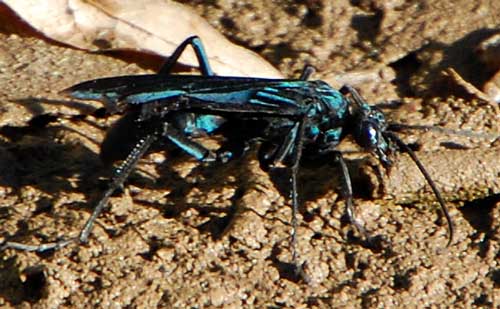Tarantual Hawk
Pepsis mexicana

This large (length nearly 6 cm) blue-black Pepsis mexicana is seeking a drink of water at a stream crossing at Coon Creek, Gila County, Arizona. 8 Aug. 2009.
Pompilidae -- Tarantula Hawk Wasp Family
These tremendously large and fearsome looking wasps are often quite common in the Sonoran Desert, particularly at the middle and upper elevations. What may seem astounding is that every wasp seen represents the demise of a large tarantula spider that was hunted, stung and paralyzed, and fed upon by the wasp grub.
Only the adult female wasps hunt for tarantulas, while both males and females frequent flowers for nectar. Before beginning a hunt in suitable habitat the wasp first excavates a deep tunnel into the soil leading to an enlarged brood chamber. Once a big spider is found, typically in its own burrow, the battle begins between the two venomous giants. The wasp with its high energy fuel of nectar and its agile wings is almost always the victor. Once stung the spider goes limp, but does not die. The tarantula hawk now must drag its prey many dozens of meters to her previously excavated chamber. An egg is deposited upon the body of the hapless spider before the chamber is sealed. Left alone, the emerging grub-larva devours the spider, later forms a pupa, and finally emerges some time later (how long??) as a new hunter of giant spiders or else a male with more limited interests.